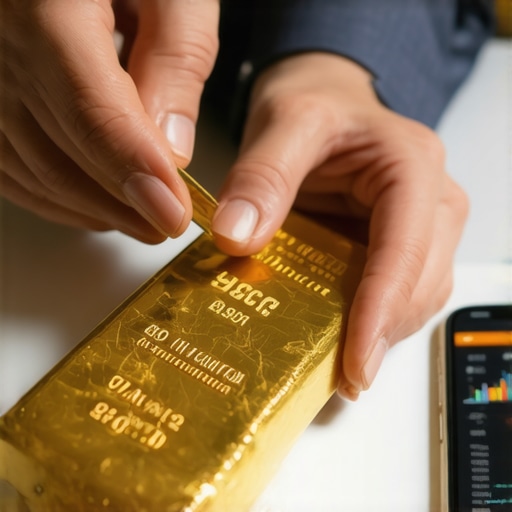Unlocking the Golden Door: Why Consider a Gold IRA?
In today’s volatile financial landscape, safeguarding your retirement portfolio with tangible assets has become more than just prudent—it’s essential. A Gold IRA (Individual Retirement Account) offers a unique opportunity to diversify beyond traditional stocks and bonds by incorporating physical gold and other precious metals. This guide unravels the complex rules and the enticing benefits of Gold IRAs, providing beginners with a clear pathway to secure and potentially enhance their retirement wealth.
Decoding the Rules: Navigating the Intricacies of Gold IRA Investments
Understanding the regulatory framework is paramount for anyone venturing into Gold IRAs. Unlike standard IRAs, Gold IRAs must comply with specific IRS regulations regarding the types of precious metals allowed, custodianship, and storage requirements. For instance, only certain purities of gold, silver, platinum, and palladium qualify, and the physical metals must be held by an IRS-approved custodian in a secure depository. Attempting to store the gold personally or investing in collectibles can jeopardize the tax advantages.
Moreover, contribution limits mirror those of traditional IRAs, capped annually ($6,500 for individuals under 50 in 2024), with strict rules on rollovers and transfers. Investors should also be aware of potential fees associated with storage, administration, and setup, which vary widely among custodians.
How Does a Gold IRA Protect Against Economic Uncertainty?
Gold’s intrinsic value and historical role as a hedge against inflation and currency depreciation make Gold IRAs particularly attractive. During periods of economic turmoil, gold often retains or increases its value while traditional assets falter. For example, during the 2008 financial crisis, gold prices surged as investors sought stability. A Gold IRA can thus act as a ballast, reducing overall portfolio volatility and preserving purchasing power through turbulent times.
The Hidden Perks: Exploring Benefits Beyond Diversification
Besides diversification, Gold IRAs bring unique advantages. Tax benefits are notable; gains within the IRA grow tax-deferred, and depending on the account type, distributions can enjoy preferential tax treatment. Additionally, physical ownership of gold provides a tangible sense of security absent in digital or paper assets.
Another nuanced benefit lies in portfolio flexibility. Investors can choose various precious metals and adjust holdings to reflect market trends or personal risk tolerance. This adaptability, combined with the long-term appreciation potential of gold, positions Gold IRAs as powerful tools for wealth preservation.
Expert Insight: Selecting the Right Custodian and Storage Facility
Choosing a reputable custodian is crucial. Look for custodians with transparent fee structures, robust security protocols, and insurance coverage. Equally important is selecting an approved depository that guarantees optimal protection and accessibility. For instance, the Delaware Depository and Brink’s Global Services are renowned for their stringent standards and reliability.
It is advisable to consult resources like the IRS website for the latest regulatory updates and to review trusted third-party evaluations before committing.
For a deeper dive on starting your Gold IRA journey, this comprehensive beginner’s guide offers step-by-step instructions and expert tips.
Share Your Thoughts: Have You Considered Gold IRAs for Retirement Security?
We invite you to share your experiences or questions in the comments below. Engaging with a community of informed investors can provide additional perspectives and help refine your investment strategy.
For further authoritative information, the IRS official page on IRAs provides detailed guidelines and updates essential for compliant and optimized investing.
Reflecting on My Own Gold IRA Journey: Lessons Learned
When I first dipped my toes into the world of Gold IRAs, I was overwhelmed by the sheer volume of information and the nuances involved. One thing that struck me early on was the importance of timing. Not just in terms of market cycles, but also in choosing the right moment to initiate rollovers or contributions. For example, I learned that waiting to roll over a traditional IRA into a Gold IRA during periods of market dips can significantly enhance the value of your precious metals holdings over time.
Additionally, my experience highlighted the necessity of meticulous research on custodians and storage options. I once nearly committed to a custodian with opaque fee structures, which would have eaten into my returns considerably. Instead, after consulting multiple reviews and speaking directly with customer service, I opted for a custodian known for transparent fees and stellar security, which gave me peace of mind.
How Can You Stay Ahead in the Ever-Changing Gold Market?
What Are the Best Ways to Monitor and Adapt to Gold Price Trends?
Staying informed is crucial when dealing with Gold IRAs. I found that regularly following trusted financial news sources and market analysis reports helps me anticipate shifts and make informed decisions. For instance, insights from Investopedia’s detailed articles have been invaluable in understanding how factors like central bank gold purchases and geopolitical tensions influence prices.
Moreover, leveraging tools like price alerts and market trend newsletters has allowed me to react quickly to market movements. This proactive approach, combined with a long-term perspective, balances the need to capitalize on opportunities without succumbing to impulsive decisions.
Balancing Physical Gold and Digital Alternatives in Your Portfolio
While physical gold provides the comforting tangibility of holding a real asset, I’ve also explored digital alternatives like gold ETFs and mutual funds. Each has its merits—physical gold is impervious to cyber risks and offers privacy, whereas ETFs provide liquidity and ease of trading.
Deciding the right mix depends on your investment goals and risk tolerance. Personally, I maintain a core of physical gold for stability, supplemented by ETFs to capture short-term market movements. This hybrid strategy enhances flexibility and diversification. If you want to dive deeper into this topic, check out my detailed analysis on physical gold versus gold ETFs.
Have You Thought About How Storage Choices Impact Your Gold IRA?
One of the less discussed yet critical aspects of Gold IRAs is storage. Choosing the right depository directly affects not only the security of your investment but also your ongoing costs and accessibility. When I first started, I underestimated how different facilities vary in insurance coverage and withdrawal policies.
For instance, some depositories offer segregated storage, where your gold is stored separately from others’, enhancing security but at a higher cost. Others provide pooled storage, which is cheaper but might complicate ownership claims. Reflecting on these options helped me align my storage choice with my priorities—security and ease of access over minimal fees.
Understanding these nuances is part of wise investing; it’s worth consulting resources like best practices for physical gold storage to make an informed decision.
What’s your approach to balancing security and cost when it comes to gold storage? Feel free to share your experiences or questions in the comments below—let’s learn from each other’s journeys!
Demystifying Gold IRA Storage: Advanced Strategies for Enhanced Security and Cost Efficiency
While basic knowledge of Gold IRA storage is widely available, expert investors recognize that storage decisions can profoundly affect both risk profiles and long-term returns. Storage is not merely about safekeeping; it intersects with liquidity, tax compliance, insurance, and even geopolitical risk. For example, choosing a geographically diversified depository network can hedge against localized political or natural risks that might otherwise imperil your assets.
Another sophisticated consideration involves the selection between segregated and commingled storage. Segregated storage ensures your gold bars or coins are individually identified and stored separately, providing impeccable proof of ownership and reducing counterparty risk. However, this premium service typically commands higher fees. Conversely, commingled storage pools assets, lowering costs but sometimes complicating claims during rare disputes.
Many seasoned investors also explore multi-custodian strategies to balance risk and optimize access. Employing different custodians in various jurisdictions can mitigate systemic risks inherent in any single institution or country. This layered approach requires diligent coordination but can substantially enhance portfolio resilience.
How Do Custodian Selection and Regulatory Compliance Influence Gold IRA Performance?
The custodian you choose influences more than just administrative ease; it impacts your investment’s security, regulatory adherence, and ultimately, profitability. Custodians vary widely in their fee structures, security protocols, and transparency. A custodian with robust anti-fraud measures, comprehensive insurance coverage, and a solid reputation is indispensable for safeguarding your assets against theft, fraud, or mismanagement.
Moreover, adherence to IRS regulations concerning asset valuation, reporting, and annual audits is critical. Non-compliance can result in penalties or jeopardize the tax-advantaged status of your Gold IRA. Leading custodians proactively update clients on regulatory changes and facilitate seamless rollovers and distributions, minimizing operational friction.
Professional associations such as the IRAHelp Custodian Directory offer vetted lists of custodians, emphasizing those with exemplary track records and transparent operations.
Integrating Technological Innovations: Blockchain and Tokenization in Gold IRAs
Emerging technologies are reshaping how investors approach physical asset management within IRAs. Blockchain, with its immutable ledger capabilities, promises enhanced transparency and security for precious metals ownership records. Tokenization of physical gold allows fractional ownership, improved liquidity, and streamlined transfer processes.
While still evolving within regulatory frameworks, tokenized Gold IRAs could revolutionize accessibility and flexibility, enabling investors to trade or allocate assets more dynamically without sacrificing physical backing. Early adopters should monitor regulatory developments closely and consult specialized advisors to navigate this complex landscape prudently.
Advanced Tax Considerations: Navigating the Nuances of Gold IRA Distributions and Withdrawals
Understanding the tax implications of distributions from a Gold IRA is crucial for optimizing retirement income strategies. Unlike traditional IRAs, the physical nature of gold complicates valuation and liquidation during withdrawals. Investors must plan for potential liquidity constraints and market timing to avoid unfavorable tax events or forced sales at suboptimal prices.
For example, Required Minimum Distributions (RMDs) necessitate converting physical gold into cash or delivering in-kind distributions, each with distinct tax consequences. Engaging tax professionals familiar with precious metals IRAs ensures compliance and strategic tax planning, potentially leveraging Roth conversions or staggered withdrawals to minimize tax burdens.
Exploring the Intricacies of Gold IRA Rollovers: Strategic Timing and Execution
Rollovers into a Gold IRA present unique challenges compared to standard IRAs due to asset type and custodian coordination. Timing is critical; executing a rollover during periods of market weakness can optimize the purchasing power of your contribution, as metal prices tend to fluctuate based on macroeconomic factors. Additionally, understanding the 60-day rollover rule and its exceptions can prevent inadvertent tax liabilities.
Investors should also scrutinize the compatibility of their current IRA assets with approved precious metals to ensure smooth transfers. Partnering with experienced custodians who specialize in Gold IRAs can facilitate efficient rollovers, minimizing delays and fees.
By mastering these operational complexities, investors can fully leverage the diversification and protection benefits Gold IRAs offer.
Elevating Your Gold IRA Strategy with Multi-Jurisdictional Custodianship
For seasoned investors aiming to fortify their Gold IRAs against systemic risks, deploying a multi-jurisdictional custodian strategy is an advanced tactic worth considering. By diversifying custodians across different regulatory environments and geopolitical regions, investors can mitigate potential disruptions such as political instability, regulatory shifts, or natural disasters impacting a single locale. This approach demands rigorous due diligence to coordinate compliance, reporting, and asset accessibility, yet it significantly enhances resilience and control over precious metal holdings.
Furthermore, integrating custodians that leverage cutting-edge security technologies—such as biometric access controls and real-time inventory audits—can further safeguard assets while streamlining administrative overhead.
How Can Blockchain-Enabled Tokenization Transform Gold IRA Liquidity and Transparency?
The advent of blockchain technology introduces transformative potential for Gold IRA investors through tokenization of physical gold assets. Tokenization converts tangible gold holdings into blockchain-based digital tokens that represent fractional ownership with immutable provenance and secure transferability. This innovation enhances liquidity by enabling easier trading and reallocation within IRA frameworks while maintaining physical backing, thus preserving the intrinsic value and IRS compliance.
However, regulatory clarity remains evolving, and custodians incorporating tokenized assets must navigate complex compliance landscapes. Early adopters should collaborate closely with legal and financial experts to ensure their tokenized Gold IRAs align with IRS rules and maximize investor protections.
For a rigorous exploration of blockchain’s impact on precious metals investing, see the detailed analysis by the Investment Executive, a respected authority in financial innovation.
Advanced Tax Strategies: Navigating Complex Distribution Scenarios in Gold IRAs
Distributions from Gold IRAs require nuanced tax planning due to the physical asset nature and valuation complexities. Investors must anticipate timing withdrawals to coincide with favorable market conditions to avoid forced liquidations at depressed prices. Strategic use of Roth conversions can shield future gains from taxation, but they necessitate careful evaluation of current versus projected tax brackets.
Additionally, in-kind distributions, where physical gold is transferred directly to the IRA owner, pose logistical and tax-reporting challenges. Coordinating with custodians experienced in precious metals IRAs and tax professionals versed in IRS precious metals guidelines is essential to optimize tax outcomes and ensure compliance.
Proactively modeling distribution scenarios using advanced financial software tools can further refine withdrawal strategies and minimize unintended tax liabilities.
Call to Action: Harness Expert Insights to Optimize Your Gold IRA Portfolio Today
Unlock the full potential of your Gold IRA by embracing these sophisticated strategies—multi-jurisdictional custodianship, blockchain integration, and advanced tax planning. Engage with specialized advisors who can tailor solutions that align with your financial goals and risk tolerance. Share your questions or experiences with these advanced facets in the comments below and join a community of expert investors committed to securing and growing their retirement wealth in gold.
Frequently Asked Questions (FAQ)
What exactly is a Gold IRA and how does it differ from a traditional IRA?
A Gold IRA is a self-directed Individual Retirement Account that allows investors to hold physical gold and other approved precious metals as part of their retirement portfolio, unlike traditional IRAs which primarily hold paper assets like stocks and bonds. This structure provides diversification and protection against market volatility and inflation.
Which types of gold and precious metals qualify for inclusion in a Gold IRA?
The IRS permits only certain purities and forms of gold, silver, platinum, and palladium coins or bars to be held in a Gold IRA. For example, gold must be 99.5% pure or higher, and coins like the American Gold Eagle are approved despite slightly lower purity due to their government backing. Collectibles and numismatic coins are not eligible.
How does storage work for a Gold IRA and why can’t I keep the gold myself?
IRS regulations mandate that physical metals in a Gold IRA must be held by an approved custodian in an IRS-approved depository. Personal storage is prohibited to maintain the tax-advantaged status of the account and to ensure asset security, proper valuation, and audit compliance.
What are the key fees associated with Gold IRAs and how can they impact returns?
Typical fees include setup fees, annual custodian fees, storage fees for secure depositories, and sometimes transaction fees. These can vary significantly among providers and should be carefully evaluated as they affect net returns over time, especially given the typically long investment horizon of retirement accounts.
Can I roll over funds from my existing IRA or 401(k) into a Gold IRA?
Yes, rollovers are allowed but must adhere to IRS rules such as the 60-day rollover window and asset eligibility. Working with experienced custodians ensures compliance and smooth transfer, avoiding unintended taxes or penalties.
What are the tax implications when taking distributions from a Gold IRA?
Distributions are generally taxed as ordinary income unless the Gold IRA is a Roth IRA. Physical gold withdrawals require converting metals to cash or taking in-kind distributions, each with unique tax reporting requirements. Advanced planning with tax professionals is recommended to optimize outcomes.
How does blockchain technology and tokenization influence Gold IRA investing?
Blockchain enables enhanced transparency and security by providing immutable ownership records. Tokenization allows fractional ownership and improved liquidity but is still emerging within regulatory frameworks. Early adopters should proceed cautiously and consult experts to ensure compliance.
Is it better to choose segregated storage or pooled storage for my Gold IRA?
Segregated storage offers individually identified metals exclusively owned by the investor, enhancing security and clarity of ownership but at a higher cost. Pooled storage is more cost-effective but commingles assets, which may complicate claims in rare circumstances. The choice depends on investor priorities regarding cost versus control.
How can multi-jurisdictional custodianship strengthen my Gold IRA strategy?
Diversifying custodians across different geographic and regulatory regions mitigates risks associated with political instability, regulatory changes, or localized disasters. Though more complex to manage, this advanced approach enhances asset security and portfolio resilience.
What steps can a beginner take to start investing in a Gold IRA safely and effectively?
Beginners should conduct thorough research on custodians, understand IRS rules for precious metals IRAs, compare fees and storage options, and consider working with financial and tax advisors. Starting with small contributions and gradually increasing exposure as knowledge grows helps mitigate risk.
Trusted External Sources
- Internal Revenue Service (IRS) – Retirement Plans and IRAs: The official IRS page provides authoritative guidelines on IRAs, including detailed rules for Gold IRAs, contribution limits, rollovers, and tax implications, essential for compliance and planning.
- Investment Executive – Blockchain and Precious Metals: This respected publication offers in-depth analysis of technological innovations like blockchain and tokenization impacting precious metals investing, useful for understanding emerging trends.
- IRAHelp Custodian Directory: A vetted resource listing reputable custodians specializing in Gold IRAs, highlighting transparency, security, and regulatory adherence, invaluable for selecting trustworthy service providers.
- Delaware Depository and Brink’s Global Services: Leading approved depositories renowned for secure storage solutions and insurance coverage, critical for safeguarding physical assets within Gold IRAs.
- Investopedia – Gold’s Role in Portfolio Diversification: Provides comprehensive insights into gold’s historical performance, economic role, and strategic portfolio applications, helping investors grasp foundational concepts.
Conclusion: Mastering Gold IRAs for Robust Retirement Security
Integrating physical gold and other precious metals into your retirement portfolio via a Gold IRA offers a compelling strategy to mitigate economic uncertainty, diversify holdings, and preserve long-term wealth. Navigating the complex regulatory landscape requires careful custodian selection, understanding storage nuances, and proactive tax planning. Emerging technologies like blockchain and multi-jurisdictional custodianship present advanced avenues to enhance security and liquidity, though they demand expert guidance.
By embracing these sophisticated strategies and leveraging trusted resources, investors can confidently position their Gold IRAs to withstand market volatility and optimize retirement outcomes. We encourage you to apply these insights, engage with knowledgeable communities, and continue exploring evolving opportunities to secure your financial future with gold.
Share your experiences, ask questions, or explore our related expert content to deepen your Gold IRA knowledge today!











I’ve been exploring the idea of diversifying my retirement portfolio with a Gold IRA after reading this comprehensive guide. The point about gold acting as a hedge against economic uncertainty resonated with me, especially considering the volatility we’ve seen in recent years. What struck me most was the importance of selecting the right custodian and depository. I hadn’t realized how significant the differences in fees and storage security could be until I started researching. The segregation of storage versus pooled storage is something that seems worth considering thoroughly since it affects both security and cost. Personally, the security and ownership clarity offered by segregated storage appeal to me despite the higher fees. Another aspect that caught my eye was the advanced strategies involving multi-jurisdictional custodianship, which seems ideal for mitigating geopolitical risks but also sounds more complex to manage. Has anyone here implemented such a multi-custodian strategy? I’d be interested to hear about the practical challenges and rewards experienced. Also, how do you balance the tangible comfort of physical gold with the liquidity benefits of digital alternatives like ETFs within your retirement planning? Looking forward to learning from others’ experiences.